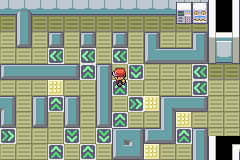Spin tile: Difference between revisions
m (→Stop tile) |
Pale Prism (talk | contribs) No edit summary |
||
| Line 1: | Line 1: | ||
{{move|Spinner}} | |||
{{Unknown name}} | {{Unknown name}} | ||
[[File:Spinner demo.png|frame|right||{{ga|Red}} stepping on spin tiles in {{game|FireRed and LeafGreen|s}}]] | [[File:Spinner demo.png|frame|right||{{ga|Red}} stepping on spin tiles in {{game|FireRed and LeafGreen|s}}]] | ||
Revision as of 20:26, 4 August 2021

|
It has been suggested that this article be moved to Spinner. Please discuss whether or not to move it on its talk page. |

|
The subject of this article has no official name. The name currently in use is a fan designator; see below for more information. |

A spin tile is a tile featured in numerous core series games. The official name for this tile, if there is one, is unknown. This tile, when stepped upon, will move the player in the direction of the arrow(s) depicted on it. The player will continue to travel in that direction until they hit a wall, land on another spin tile (which may send them in a different direction), or land on a stop tile, a tile only used for this purpose. The name 'spin tile' comes from the fact that the player is spun around while traveling.
Locations
Spin tiles are generally associated with Team Rocket, and are first found in the Team Rocket Hideout, where they form a complex maze that the player must work out to navigate the building. Other places with spin tiles involving Team Rocket include the Rocket Warehouse and Viridian Gym. They also appear in the northwest wing of Team Rocket's Castle, the base of Team Rainbow Rocket, in Pokémon Ultra Sun and Ultra Moon. Interestingly, Viridian Gym continues to use spin tiles in Pokémon HeartGold and SoulSilver, despite Blue being the Gym Leader in Generation IV rather than Giovanni.
In Hoenn, they appear in the Trick House and Mossdeep GymRSE. In Sinnoh, they appear inside the Fuego Ironworks.
After being absent in Unova, spin tiles and stop tiles make a return in Kalos, being found in Lysandre Labs.
Differences between games

|
This section is incomplete. Please feel free to edit this section to add missing information and complete it. Reason: Images from XY and Let's Go |
In Generation I, all spin tiles lead to stop tiles, and the arrows on the tiles move while the player is spinning. In Pokémon Yellow, Pikachu spins with the player. In Pokémon Ruby, Sapphire, Emerald, FireRed, and LeafGreen, the arrows no longer move while the player is spinning; there are no stop tiles in Pokémon Ruby, Sapphire, or Emerald. In Pokémon Diamond, Pearl, and Platinum, there are no stop tiles; instead, the player spins until colliding with a wall. In Pokémon HeartGold and SoulSilver, stop tiles return and spin tiles are colored based on the direction in which they send the player.
Additionally, the spin tiles in Pokémon Ruby and Sapphire behave differently than in other games. The player does not spin, and when pushed onto a normal tile, stops on it. Spin tiles in Pokémon Emerald act as normal tiles that don't push the player at all; they only spin around other tiles at the press of a button, while pushing objects and NPCs on it.
Spin tile
|
Stop tile
|
| Special tiles in the Pokémon games |
|---|
| Cave tile • Hole • Ice tile • Ledge • Marsh tile • Puddle • Sand tile • Snow tile Spin tile • Soft soil • Tall grass • Trap • Warp tile • Water tile Dungeon tile |

|
This game mechanic article is part of Project Games, a Bulbapedia project that aims to write comprehensive articles on the Pokémon games. |